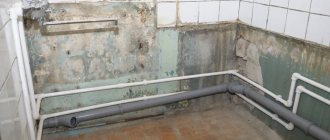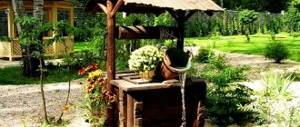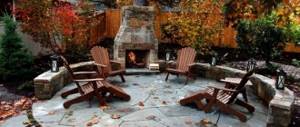Foreign examples of reconstruction of old houses
I created a topic on the portal where I invited users to demonstrate their favorite options for the reconstruction of houses, both Western and Russian. The principle is this: we show “Before” and “After” photos. Share your experience and comment. We talk about the location of the reconstruction, the timing and features of the projects. I'll start, I guess.
An old house converted into a modern cottage near New York.
The roof was updated by laying flexible tiles with a new pattern.
Interior of a house on the attic floor.
And this is an example from fedot84. An old barn in the Swiss Alps has been converted into a cozy holiday home for tourists.
The old log house was carefully dismantled , each log sorted.
The basement floor was poured on a slope.
The old-new frame was reassembled on a concrete “pedestal”.
The interior of the house with stunning views from panoramic windows.
After reconstruction, the house organically blended into the natural landscape.
In the photo below is another example from Switzerland - the reconstruction of a 19th century stone house into a stylish cottage, made in 2005.
The highlight of the project is that the attic walls in the house were built using monolithic technology.
We installed new windows and made a beautiful roof without an eaves overhang.
The cottage looks both authentic and modern at the same time.
Only the kingdom of concrete and stone.
Concrete polished floor.
And another stylish project from Switzerland - a house on a slope.
The house is assembled from used materials left over from old buildings.
But the interior is a wooden remake.
And again, a foreign example is an old pigsty built in 1762, turned into an architect’s office.
The creators of the project thought outside the box - making a house within a house.
Due to the dilapidation of the walls, they did not repair the pigsty, but simply put a “box” assembled from plywood into it, like a nesting doll.
The buildings - new and old, are separated from each other and do not even touch the roof.
The stone and plywood houses have independent foundations.
In the evening, when the house is illuminated from the inside, the contrast of the brutal old volume and the minimalist new content seems especially attractive.
All the examples above clearly demonstrate the Western approach to reconstruction - old houses are treated with care . They try not to demolish seemingly outdated dilapidated houses and build new buildings in their place, but preserve history by organically combining old and modern materials.
But you have to pay for everything. Reconstruction is often a very expensive proposition, and not everyone can afford it. There is one more “but” - domestic specifics.
Abroad, contrary to our prevailing opinion, most often it is not family castles that are reconstructed, but old houses or outbuildings - barns, stables, etc. Why don't they do this in our country? Tell me, have you often seen a private barn or barn built from natural stone? Reconstruction requires a solid foundation. Which in itself is worth the trouble of rebuilding and improving.
For example, if there is still some sense in reconstructing an old but well-preserved wooden house in a picturesque place, then the feasibility of remodeling a collapsed wooden hut with ceilings less than 2 m high, standing on a foundation sunk into the ground, is a big question.
LiveInternetLiveInternet
Quote from Milendia_Solomarina
Read in full In your quotation book or community!
Country interiors: wooden houses
A selection for summer residents, and for those who are still dreaming of a country house, harboring the idea of transforming an old country house into something beautiful. The Internet is full of ideas for remodeling European old houses, but this selection is for our, domestic log houses. From the ideas below, you can see how to increase the size of the house, redraw the layout, modernize, but not depersonalize the cozy interior of the log house.
The balance of antiquity and modernity in a cozy country house should be approximately equal. The main points (ceiling height, window size, general appearance, stove) remain unchanged, but the materials from which all this is made are high-quality, modern. You don’t want to build a hut on chicken legs, or a museum, meticulously selecting ancient utensils, denying yourself amenities and modern technologies :-)
Bleached pine boards instead of clapboard paneling are a wonder at how they refresh the interior:
Again modernized, painted trim options:
Next are a few more Provence interiors (rustic plaster on wood)
.
The wall overlooking the mountain cliff has been replaced with triple glazing (feels like the Alps!)
13.
14.
And this interior with a painted stove on all floors is also Russian, a conversion from an old building!
6.
7. 8.
9.
12. 13.
14.
Solid, even rich merchant interior of a country house:
16.
For those who want to feel the village atmosphere and plunge into the life of “fugitives from civilization,” I suggest a couple of books:
Osta Holt "The Poor Man's Cookbook, or the Chronicle of a Small Land Farm." This is a story about Annetta, a 23-year-old woman who decided to move alone to her farm abandoned during the war. Neither her husband nor her parents supported her in this venture. But gradually Annetta restores the destroyed farm, gets a cow, sheep, chickens, and begins to learn how to weave on her grandmother’s loom. Language - with folk figures of speech, with Norwegian proverbs and sayings. There are many descriptions of pre-war life, antiques and devices, clothing. Here is the link, https://docs.google.com/file/d/0B2H1NE2wh2C7dnhWUUpnQV9qaFk/edit
Another interesting book: Joan Harris, Tea with the Birds
Stories about the magic of the everyday, questions like “what happens to the negative characters when the fairy tale ends” or “where do ideas that are not useful go” create a feeling of imperceptible magic in everything - in an old cookbook, a low hostel on a quiet street, newspaper clippings . Joan creates another reality, and in this reality, birds may well live in the refrigerator, old women buy red patent leather shoes, and banal cooking can bring unpredictable results (and this is not a burnt dessert).
For example, the story “Sister” about what happened to Cinderella’s sisters, “Edition of Eighty-one” - about what happens when the magic ends and “Free Spirit” read HERE https://knijky.ru/books/chay-s -pticami can be downloaded here
https://fanread.ru/book/6050788/ or HERE https://royallib.com/book/harris_dgoann/chay_s_ptitsami.html
And finally, a funny parable about village life:
“The sparrow froze on the branch and fell from it to the ground. A cow walked by and her cake hit the sparrow. He warmed up under her and chirped, and the cat, hearing him, pulled the little sparrow out of the cake and ate it. Moral: not everyone is an enemy who puts you in shit. Not everyone is a friend who pulled you out of shit. And most importantly, don’t tweet, sit in the shit.”
Remodeling brick houses “hello from the 90s!” to stylish cottages
Users of the portal have accumulated extensive and successful experience in the reconstruction of old and unfinished houses. Unlike Western builders, compatriots have to take into account local realities and be smart.
My friend bought an unfinished house. We decided to reconstruct it. Redesign the layout. Improve the façade. And all this so as not to go broke.
It turned out beautiful and stylish.
And this is a remake of a classic unfinished building from the 90s.
The result is a modern and beautiful house.
Another standard house from the 90s, as was customary then - always made of red brick.
Such design and finishing solutions are, of course, outdated today.
The house was given a second youth by converting it into a beautiful and fashionable cottage in the English style.
And another reconstruction project.
And this is what ended up happening.
The facade of the house was insulated and decorated with decorative tiles to resemble textured brick.
Competent reconstruction is based on economic calculations. If the foundation is strong and the walls are not cracking, then why not add a second floor to the “box”. Build an attic or extension. There are plenty of options. The main thing is to calculate everything properly and understand what is more profitable and economical - demolishing the house or remodeling it.
Construction of houses
16 votes
+
Vote for!
—
Vote against!
Not every homeowner builds a home from scratch. Someone inherits a country property, someone buys a plot of land with a finished building, which for some reason he doesn’t like. In addition, in the spring, inconveniences and unacceptable shortcomings are often discovered in an already built house, or the family grows and the house becomes cramped for it. Then it is necessary to make a difficult decision related to the reconstruction of a private house - an extension, a superstructure or a repair. And often the owners try to redo everything with their own hands.
Reasons for reconstruction
Nowadays, the country's housing stock includes a fairly significant sector of “dilapidated” houses built more than 30 years ago. In most cases, they are now in an uninhabitable state. Naturally, owners of such real estate try to get rid of such objects by selling them to buyers for next to nothing, because they are more interested in a piece of land than in what is built on it.
You can, of course, demolish the old house and build a new one in the vacant space. However, you can do without this. Properly organized and completed reconstruction of a country house will allow it to be turned into the most modern cottage that meets the highest requirements of comfort and coziness. In this matter, it is of great importance how to legalize the reconstruction of a private house.
Documentation
Sometimes it happens that you can make your home cozier and more convenient only through major changes in its design, and it is unlikely that you can get by with just redevelopment. The construction of a veranda, the addition of additional floors and other construction work that is associated with changes in technical and economic indicators (total area and construction volume) and the functional purpose of private houses fall under the concept of “reconstruction”.
The rules for reconstruction are regulated by the regulations on the procedure for reconstruction of residential private houses and non-residential buildings. According to this regulatory act, before carrying out reconstruction, it is necessary to submit an application to the local government authority, which must, within a month, make a decision on permission to reconstruct a private house or a reasoned refusal and inform the applicant about this in writing.
In addition to the application, you must provide the following documents: a development plan for the land plot, which was completed by an individual entrepreneur or legal entity that has the appropriate permit; description of work to change the purpose or physical parameters of the premises of a residential private house; written consent of all residents, including those temporarily absent for the reconstruction of the house.
In addition, the applicant must provide copies of documents that certify ownership of a private house and plot of land. Having permission in hand, the developer develops the project, removes the axes of the reconstruction works and opens financing.
Attic conversion
How can you achieve the result described above? It is best to start rebuilding a private residential building from the attic. If its height and area are too small, then it is recommended to simply think about insulating the room to avoid heat leakage through the ventilated attic from the main house. If the area of this room is large enough, then it is an unaffordable luxury to lose it and in such a situation you need to seriously think about converting the old attic into an attic.
The initial task is to strengthen the floor, for which you need to strengthen the rafters with a corner and place new strong logs, preferably made of timber. It is also important to take care of the thermal insulation of the roof slopes, which serve as the walls of the future attic. For this, it is best to take mineral wool panels, although you can also use more modern rolled materials if funds allow.
An essential component of such a “pie” is a vapor barrier layer that allows air to pass through only in one direction. It is also recommended to replace the roof, because you know that metal roofs make a lot of noise when there is wind or rain. This is unimportant for a non-residential attic, but for a residential attic it is of great importance. Therefore, it is better to buy soft roofing materials, which also have excellent thermal insulation properties.
Foundation
Completing the second floor and converting the attic of a house into an attic invariably leads to an increase in the total mass of the residential building, and therefore provokes an increase in loads on the foundation and requires the preparation of certain documents for the reconstruction of a private house. Therefore, it is necessary to carefully study its external and internal condition, for which you should not limit yourself solely to a superficial inspection of the above-ground surface of the foundation. You will have to drill a hole to the entire depth of the foundation.
If you find defects, you need to try to take measures and try to do everything to strengthen it. If you have a log house, which is not uncommon for old buildings, it is also necessary to examine the lower crowns of the log house. They often rot over time, which reduces the stability of the structure. If there are rotten fragments, they should be replaced immediately.
Main room
When reconstructing a private house with your own hands, the question of remodeling the main room often arises. In this case, some problems arise - to combine the space, it may be necessary to remove the wall, which is a load-bearing one. In such a situation, it will not be possible to demolish it cleanly; you will have to replace the wall with a special structure created from articulated supports with support walls and beams laid on them.
This allows you to preserve the load-bearing capacity of the housing and unite the space; if you wish, the beam and supports can be decorated with plasterboard panels. When choosing this approach, it is important to take special care at each stage of the work. This is exactly the case when it is recommended to play it safe once again rather than risk it and end up with a collapse of the structure.
Brick wall repair
Brickwork is often done carelessly, so in old private houses the walls need to be finished in such a way that they look more beautiful. To do this, it is necessary to restore the broken parts of the bricks by first preparing the mortar, treating the seams and giving them a concave or straight shape.
In the early stages, it is important to identify the reasons for the formation of deformations in the masonry and check its quality, horizontalness, thickness of the dressing and seams. It is customary to dismantle brickwork laid on mixed or low-grade lime mortar using electric hammers and pneumatic jackhammers.
The masonry is dismantled in sections approximately 1.5 meters long. The masonry should be dismantled in horizontal rows, starting from the top of the wall. The brick must be cleared of the mortar with the sharp end of a pick and lowered down through closed gutters. Crushed stone is also poured down the gutters.
It is recommended to break concrete and rubble masonry manually using a pneumatic or electric hammer with a striking part in the form of a lance or a flat blade. Weathering of seams is usually eliminated by strengthening the seams with cement mortar.
Jumpers with some cracks need to be restored by injecting a special liquid into them - polymer cement or cement mortar. When repairing arched lintels, you need to remove the loads from the floors from them and subsequently reposition them. When repairing ordinary and wedge lintels, they should be reinforced with reinforced concrete or steel beams.
The most optimal method of increasing the load-bearing capacity of a brick wall with a low grade of masonry mortar is through peripheral replacement of mortar, which exists on a polymer-cement base, in the masonry joints. The advantage of this method, along with significant savings, is restoration without increasing the mass of the brick wall and reducing the internal dimensions of the premises.
If cracks appear under the supports of purlins and floor beams, it is necessary to replace sections of the masonry, install a reinforced concrete backing slab, having previously made temporary vertical fastenings before its installation.
Repair of wooden walls
When repairing the wooden walls of an old house, it is necessary to restore the base, replace sections of the walls and lower crowns in the walls and under the windows, level and hang the housing during subsidence, and seal the openings in the wooden walls. When repairing the basement, the wooden fence is replaced with a brick one. When replacing rotten logs and beams, you need to hang up the overlying crowns using jacks, and when replacing the beams of the upper crown, you need to hang up the attic floor and rafters.
Rotten logs must be replaced with new ones. A three-layer roofing material should be laid on the foundation, and the lower surface of the crown should be treated with an antiseptic and bitumen. When replacing rotted lower crowns with brickwork, it is customary to make waterproofing between the new masonry and the foundation, between the preserved crowns and the new masonry.
To strengthen wooden walls, install vertical clamps consisting of 2 beams every 2 meters, which have a cross-section of 12 by 14 centimeters for one-story private houses and 15 by 20 centimeters for two-story houses. It is customary to tighten the bars with bolts every meter along the height of the compression. Install the first bolts at a distance of 30 centimeters from the compression end.
When making openings, the jambs and the crowns of the walls are connected with a tongue and groove. If settlement of the walls has stopped, do not leave a gap above the opening, but lay insulation. The side jambs are left, and the top and bottom cushion are removed. The opening must be filled with beams or logs, repeating the design of a wooden wall.
Reworking floors
Repair of floors is carried out by replacing the roll-up, or by strengthening individual wooden beams and the structure of the floors in general over the entire area. After removing the floor, insulating material, vapor and sound insulation layers and rolling, it is customary to inspect the wooden beams. To repair, remove the skull blocks, clean the beams and reinforce with side plates, while installing them with nails or bolts. Place a temporary support under the structure to be repaired and remove the unusable part of the beam.
Prefabricated reinforced concrete floors that have to be repaired are divided into:
- floorings that rest on the walls of the house and cover the entire span between the load-bearing brick walls;
- floors that consist of individual reinforced concrete beams of different profiles and filling in the form of lightweight concrete liners or slabs that lie on the beam flanges;
— prefabricated monolithic floors, which consist of beams with reinforcement exposed at the top of the section, on which vaulted or ribbed reinforced concrete slabs are laid, and the voids are filled with concrete;
— monolithic floors, which consist of small blocks, which are laid on a temporary flooring with grooves into which monolithic concrete and reinforcement cages are laid.
Often the reconstruction of an old private house is carried out without dismantling the covering and ceilings, then it is better to place the ceiling elements into the window opening. When a private house requires dismantling of floors and coverings completely, it is most rational to use large-sized floorings.
Partition repair
Repair of partitions includes the following work: complete replacement of dilapidated partitions or installation of additional partitions when choosing the redevelopment of premises; rearrangement and strengthening of partitions; replacement of frame posts, frames and individual wood elements; partial or general consolidation of elements of shrunken partitions with the addition of boards; constructing new or sealing existing openings in partitions, as well as hanging partitions that have sagged.
Ask what documents to prepare for the reconstruction of a private house. When reconstructing an old house, it is customary to dismantle the existing partitions and erect new ones from gypsum-fiber, gypsum-plaster and gypsum-concrete slabs, as well as from lightweight concrete and ceramic stones and bricks. Partitions are laid from different materials - brick, stones and gypsum boards. The brick partitions are a quarter of a brick thick and 3 meters long and high. If the height and length are greater, then it is customary to lay half a brick.
Partitions can be reinforced with thin reinforcing wire, which has a diameter of 6 millimeters, to ensure their stability. Where the structure intersects with the main wall, it is necessary to drive in steel pins. To make the brick partition reliable, make it strictly vertically, filling each seam well with mortar. Brick partitions in bathrooms should be half or a quarter brick thick, and they are usually laid out according to a metal template with markings.
If there is a doorway in the partition, the box must be installed after the second row of gypsum concrete slabs, fastening is carried out with wood plugs, which are usually laid in 3 places between the slabs on both sides in height and filled with gypsum mortar. The lintels are placed in gypsum partitions symmetrically relative to the center of the existing opening.
After this, a gap is left between the partition and the ceiling for settlement of the structures. Later it should be caulked with tow and gypsum mortar. The dressing of the seams is observed when pairing the partitions. Place anchors made of reinforcement into the horizontal seams, pre-coating them with bitumen varnish, use brushes when attaching to the outer wall, placing them along the height of the entire wall in three places. There, lay steel reinforcement in horizontal joints along the length of the wall to ensure its stability.
Completing stage
The most difficult thing in a private house reconstruction project and façade finishing is choosing a specific option from the many proposed solutions. The modern market of finishing materials for facades provides a wide range of products: from artificial stones to vinyl siding.
Serious problems can arise when updating communications. Most private houses of old construction are not equipped with running water and sewerage. This is unacceptable for modern people. Connecting to city communications laid nearby does not pose a problem from a technical point of view; the technology for such connections has been developed for a long time.
However, again, most of the time has to be spent on coordination with utility services and local authorities, who are happy that developers are doing their work at their own expense and with their own hands, but at the same time they still cannot refuse bureaucratic delays. So in this case you will have to be patient.
Thus, you understand that designing the reconstruction of a private house - an old village or country house - is not an easy task, but it is completely solvable. Therefore, if you wish, you can easily turn your old, but not too dilapidated building into a comfortable and modern home for your family without much expense.
Barn house (barn house) in Russian, or how to convert an old hut into a beautiful cottage
Some domestic developers believe that barn houses, popular abroad, are completely unsuitable for us. And their architecture is kind of strange. And they don’t fit into their native landscape. And in general, this is a class element alien to us. What if professional architects get down to business? And they do not blindly copy a Western project, but thoughtfully reconstruct an old village log house - a real family nest from the last century, starting from the national flavor and only slightly modernizing it.
To be honest, I am torn by contradictions. The result was a real Russian barn house, although I liked the project better. But such a house will definitely not leave anyone indifferent.
The log house is located in the Tver region and the main condition of the customer was to reconstruct the old hut, so as not to destroy its originality, but at the same time increase the area for a large family to live.
The geometry of the oblong section suggested the reconstruction path to the architects.
Please note that on the front part, when looking from the entrance to the site, the log house has retained the traditional rustic facade with small windows.
The rear private part looks more modern, and is glazed with floor-to-ceiling windows, and the “carelessly” torn logs give the entire volume of the log house additional dynamics.
The side facades are cut through by many windows, creating a “spontaneous” composition on the facade and an interesting play of light in the interior.
Converting a dacha into a house for permanent residence
Old houses are not always reconstructed. Sometimes people take on the task of remodeling a good-quality building that needs to be raised to the level of permanent residence.
There lived a well-built dacha. The only thing it lacked was normal insulation for year-round use. Therefore, the owner took up the reconstruction and this is what he ended up with.
The reconstruction was divided into a number of stages:
We made a redevelopment: we enlarged the kitchen, added a second bathroom and made two comfortable ones out of three small bedrooms.
We added a living room, a porch and added a bay window, which made it possible to place a dining room in it.
A terrace was added to the south side and a doorway leading to the garden was made.
The extension to the house was made using frame technology.
The house was well insulated and covered with larch boards.
The living room is an open multifunctional space with a stove-stove and a large glass area, creating an atmosphere of home comfort.
How to turn an old garden house into a “candy” for pennies
Cozy country interior for pennies!
Background
My sister and I came up with the idea of purchasing a small summer cottage when we were 22 and 25 years old, respectively. We are both passionate about decorating and we wanted to bring to life various interesting ideas, as well as have a place where you can simply relax from the bustle of the city and enjoy being close to nature.
The place was not chosen by chance - overlooking an ancient pine forest, on the other side of which our grandparents once lived and with which our happy childhood is therefore associated.
View of the pine forest from the attic
Buying a house
The plots in this SNT are small - only 3 acres, but we were primarily interested not in the vegetable garden, but in the house. Therefore, we immediately rejected proposals with plots turned into one continuous bed.
... And finally, luck smiled on us - an elderly man responded to an ad written by hand - his old friend was selling a plot of land with a house. When we saw him (the house, not the man) it was love at first sight! A plank house with an attic and an overgrown garden! We asked for the owner's phone number and immediately agreed on the purchase without haggling on the price (and it turned out to be much lower than we expected!). So we became his happy owners.
Transfiguration. Start
The house was made with love, but it was already very “neglected”. We wanted to breathe new life into it by renovating it without spending a lot of money. We initially decided that this would be a “budget” renovation, and wanted to prove that beautiful and cozy does not mean expensive.
This is what the house looked like at the time of purchase and the start of cleaning: old wallpaper yellowed from time and stains on the roof, an old bed and gray chairs:
Spring bed USSR
The wall opposite the bed (let’s call this place so that it’s convenient to compare later











